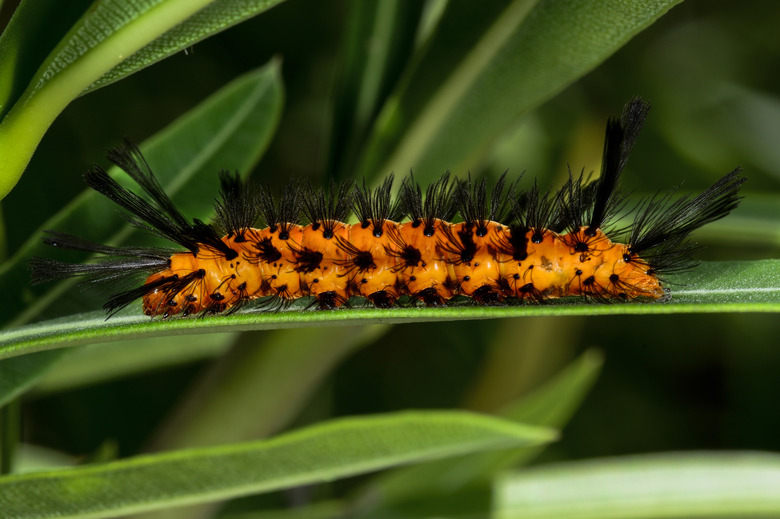Caterpillars Are Eating My Desert Roses
When caterpillars are eating your desert rose plants (Adenium obesum, USDA zones 11-12), you want solutions fast to save your plant. How these plants became known as desert roses is anybody's guess, because they are far as plants get from the ornamental roses (Rosa spp.).
Desert roses' twisting, grayish-green branches fan out from a bulging base of water-storing humps. Cut into one of them, and it oozes toxic sap favored by African tribal hunters as a poison lethal to big game. In some areas across their hardiness range, these bizarre plants attract caterpillars nearly as strange as they are.
Oleander Caterpillars Eating Desert Roses
Oleander Caterpillars Eating Desert Roses
Long, black bristles sprouting from black, wart-like bumps on their bright-orange bodies give oleander caterpillars (Syntomeida epilais jucundissima) the look of escapees from a Halloween-themed horror movie. After growing from 1/10 to 1 1/4 inches long during a month-long eating binge, they leave desert roses to spin black-shrouded clusters of brown cocoons.
After pupating, they emerge as iridescent, white-spotted blue-green polka-dot wasp moths to mate and lay clusters of creamy-white eggs on the undersides of their host plants' leaves.
Feeding Damage to Desert Roses
Feeding Damage to Desert Roses
Groups of the newly hatched caterpillars chew through the undersides of the new leaves, turning them brown. After molting three times, the groups separate, and individual caterpillars begin devouring entire leaves. Without treatment, oleander caterpillars may completely strip a desert rose's sparse foliage. Desert roses seldom die from oleander caterpillar infestations, but repeated leaf loss may sap their ability to withstand damage from other pests.
Oleander Caterpillar Predators
Oleander Caterpillar Predators
Their diet of toxic desert roses takes these caterpillars off the menu of caterpillar-preying birds and small mammals. The ominous-sounding, shield-shaped spined soldier bug, however, chows down on them with gusto. This predatory stink bug injects the caterpillars and polka-dot wasp moth eggs with paralyzing, tissue-dissolving enzymes and sucks out their liquefied contents. It also kills up to 90 other common plant pests.
While releasing one or two of the commercially available soldier bug eggs once or twice a month controls the caterpillars on a single desert rose, they're expensive for that purpose. If you spot the brown bugs or their round, metallic-bronze eggs in your garden, leave them alone. The beneficial insects don't harm the plants and could save them.
The larvae of tiny tachinid flies and predatory wasps also prey on oleander caterpillars. To attract the egg-laying adults, plant nectar- and pollen-producing daisy family (Compositae) flowers. Easy-care choices include annual French marigolds (Tagates patula) or zinnias (Zinnia spp.).
Cultural Control Options
Cultural Control Options
To manage the early-stage caterpillars, cut away the infested leaves with sharp pruning shears. Freeze the infested plant parts in a sealed plastic bag for a day to kill the the young caterpillars. Dispose of the plant debris in the trash. Wear gloves to protect yourself from the oozing sap, and disinfect your tools in rubbing alcohol between cuts and when you finish so they don't spread disease.
Again wearing gloves, hand-pick late-stage caterpillars. You can either freeze them in a bag or drown them in soapy water to kill them.
Microbial Control Method
Microbial Control Method
Apply ready-to-use, microbial Bacillus thuringiensis var. kurstaki spray to kill the caterpillars. Inspect the plants daily for egg masses on the backs of the leaves. When all the eggs have hatched, spray both sides of the leaves when no sun is shining on the plant. The microbes penetrate the caterpillars' intestinal walls and poison their blood.
Repeat the application after rain or every five to seven days (according to label directions) while caterpillars continue feeding. Wear protective clothing, including long pants, a long-sleeved shirt, safety glasses and a respiratory mask when spraying.
References
- University of Florida IFAS Extension: Featured Creatures: Oleander Caterpillar
- University of Florida IFAS Extension: Oleander Caterpillar, Syntomeida epilais Walker (Insecta: Lepidoptera: Arctiidae)
- University of Florida IFAS Extension: Nerium oleander
- University of Florida IFAS Extension: Featured Creatures: Spined Soldier Bug
- UC IPM: Pesticide Information: Active Ingredient, Bacillus thuringiensis var. kurstaki
